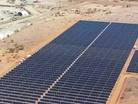Gold Fields greenlights $46mn South Deep solar project

South African bullion miner Gold Fields, which anticipates capital expenditure of around $1.17bn in 2021, has approved ambitious spending plans. The $46mn construction of a 40MW solar plant at the South Deep mine has received the green light from the National Energy Regulator of South Africa.
Renewable Energy
The 40MW solar plant will generate over 20% of the average electricity consumption of the mine. It will comprise 116,000 solar panels and cover a 118ha area roughly the size of 200 soccer fields and will be on mine property.
The estimated capital investment for the plant is R660m ($46mn), including contingencies and escalation. This will be funded from the mine’s positive cash-flows over the next two years. The use of self-generated, renewable energy will translate into savings of around R120m on the cost of electricity a year. South Deep is currently finalising procurement strategies and contractor criteria for the construction of the plant, which will begin during Q2 2021. The plant is expected to be commissioned during Q2 2022.
South Deep
Gold Fields CEO, Chris Griffith commented: “We are the first South African mine to build and operate our own solar plant of this scale. This will ensure greater reliability of power supply and reduce the cost of electricity, which currently makes up about 13% of the mine’s operating costs.
“Importantly, it will reduce our carbon footprint by around 100,000 tonnes of CO2 a year, not only enhancing the sustainability of South Deep but also contributing to Gold Fields’ long-term commitment to carbon neutrality."
During 2020, renewable electricity averaged 3% of Gold Fields Group electricity. Once the South Deep project is commissioned, renewable’s contribution to the Group total will rise to approximately 11%.
240 jobs will be created during the construction phase, while a team of 12 people will be required to operate the plant once operational. As far as possible, goods and services required to build the plant will be sourced locally within South Africa.
“A broad range of stakeholders stand to benefit more from the mine’s activities. A profitable mine and a sustainable business can continue to employ and develop employees, contribute to community development, support the livelihoods of local suppliers and add to the fiscus in the form of taxes and royalties,” says Griffith.
Gold Fields
Gold Fields' energy objectives are based on four pillars – energy must be reliable, available, cost-effective and clean – which promote a shift to self-generation using renewable energy sources. During 2020, Gold Fields successfully implemented solar and wind power plants, backed by battery storage, at two of its Australian mines, Agnew and Granny Smith, and committed to renewables at its other Australian mines, Gruyere and St Ives, as well as the Salares Norte project in Chile when it starts operations in 2023. All its other mines are also reviewing renewable energy options.
Gold Fields underlined its commitment to renewable energy sources and cleaner approaches to mining as a founding member of the Electric Mine Consortium which was launched in March.
Gold Fields has also allocated $43mn towards the development of the Huni Pit at its Ghanaian Damang mine. Meanwhile, its Salares Norte Project, in the Atacama region of Northern Chile, continued to track ahead of schedule with $86.9 million spent on the project during the quarter.



